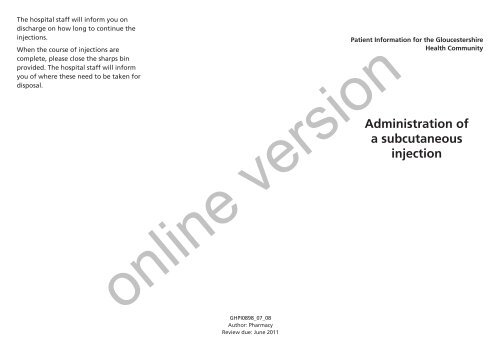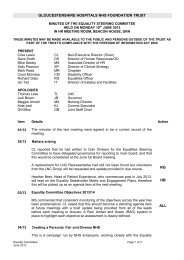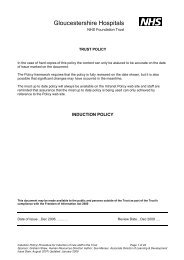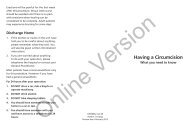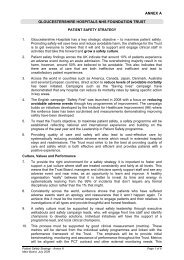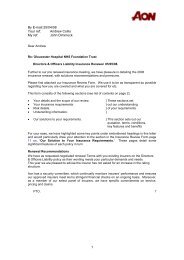Administration of a Subcutaneous Injection
Administration of a Subcutaneous Injection
Administration of a Subcutaneous Injection
Create successful ePaper yourself
Turn your PDF publications into a flip-book with our unique Google optimized e-Paper software.
The hospital staff will inform you on<br />
discharge on how long to continue the<br />
injections.<br />
When the course <strong>of</strong> injections are<br />
complete, please close the sharps bin<br />
provided. The hospital staff will inform<br />
you <strong>of</strong> where these need to be taken for<br />
disposal.<br />
online version<br />
GHPI0898_07_08<br />
Author: Pharmacy<br />
Review due: June 2011<br />
Patient Information for the Gloucestershire<br />
Health Community<br />
<strong>Administration</strong> <strong>of</strong><br />
a subcutaneous<br />
injection
Introduction<br />
The information to follow will guide you<br />
through the steps <strong>of</strong> administering a<br />
subcutaneous injection.<br />
What is a subcutaneous<br />
injection?<br />
This is an injection given in the fatty layer<br />
<strong>of</strong> tissue under the skin<br />
The most common body areas used to give<br />
these injections are :-<br />
• fleshy part <strong>of</strong> the thigh.<br />
• abdomen<br />
Your nurse will be able to give you<br />
further information on this matter. Please<br />
remember to rotate the site <strong>of</strong> the injection<br />
every day to keep the skin healthy.<br />
How do I prepare for the<br />
injection?<br />
Prepare the skin<br />
• Firstly wash your hands thoroughly. This<br />
is the best way to prevent infection.<br />
• Then wash the area <strong>of</strong> skin, unless<br />
already clean. This is aimed to prevent<br />
infection at the site.<br />
• Allow the skin to dry before giving the<br />
injection.<br />
Prepare the injection device<br />
• Take one <strong>of</strong> the pre-filled injections<br />
from the box. Please ensure that the<br />
fluid inside the syringe is clear and free<br />
from particles.<br />
• Remove the cover from the needle. Be<br />
careful not to contaminate the needle.<br />
If you are injecting Fragmin you should<br />
be able to see a small air bubble in the<br />
syringe. This can be left in the syringe<br />
for injecting.<br />
Inject<br />
• Hold the syringe in one hand like a<br />
pencil.<br />
• Then grasp 2-inch fold <strong>of</strong> the area <strong>of</strong><br />
skin to be injected between the thumb<br />
and index finger.<br />
• Then introduce the needle quickly, but<br />
in a controlled manner all the way<br />
into the skin at a 90 degree angle.<br />
The angle is important to allow all<br />
the medication to be injected into the<br />
fatty tissue. However in individuals<br />
with very little subcutaneous fat, the<br />
angle <strong>of</strong> injecting may vary. Your nurse<br />
will demonstrate this for you before<br />
you go home. DO NOT PRESS DOWN<br />
ON THE PLUNGER WHILE PIERCING<br />
THE SKIN.<br />
online version<br />
• After the needle is completely inserted<br />
into the skin, release the skin that you<br />
are grasping.<br />
• Then hold the base <strong>of</strong> the syringe with<br />
your free hand to stabilize it.<br />
• Then inject the medication at a slow<br />
steady state by pushing the plunger<br />
to deliver the drug. The medication<br />
should then be injected over no less<br />
than 5 seconds.<br />
• Then remove the needle slowly.<br />
• Do not be alarmed if you notice a small<br />
amount <strong>of</strong> blood at the injection site<br />
when the needle is removed. It is likely<br />
that you have nicked a small blood<br />
vessel when injecting. You may wish<br />
to wipe the area with a clean tissue,<br />
but do not apply pressure to the area.<br />
Slight bruising at the injection site<br />
is common. However, if the bruising<br />
worsens after 24 hours, please contact<br />
our G.P for advice.<br />
If you do have any queries/problems with<br />
administering the medicine following<br />
discharge from hospital, please contact<br />
your district nurse in your GP surgery for<br />
further assistance.<br />
Disposal <strong>of</strong> the syringe<br />
• Do not put the cap back on the needle<br />
• Discard the entire syringe in the sharps<br />
container supplied<br />
• Wash hands when finished<br />
Please store the sharps container in a safe<br />
and secure place and keep out <strong>of</strong> reach <strong>of</strong><br />
children.


